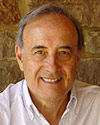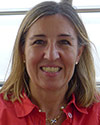2013 E.B. Burwell, Jr. AwardPresented to Luis Gonzalez de Vallejo and Mercedes Ferrer |
||
|
|
for “Geological Engineering”
|
Citation by Paul M. Santi
Geological Engineering was selected for this award because we expect it to be the new standard for engineering geology and geological engineering education. It is sophisticated enough to give senior undergraduates and graduate students an in-depth knowledge of these subjects, yet clear enough that lower level students or individuals from other fields can understand the critical concepts. Furthermore, the treatment is deep enough that the book serves as an excellent reference manual for practitioners.
The book carefully balances descriptive text, quantitative techniques for analysis, and tabulated data showing example parameter ranges and methods of evaluation. There are hundreds of beautiful full-color diagrams, maps, and photographs. Each chapter has an excellent reference list to guide further reading.
The book is divided into four sections of escalating integration of information. Part 1 covers fundamentals, with chapters introducing geological engineering, soil mechanics, rock mechanics, and hydrogeology. Part 2 focuses on methods, explaining how we get data in geological engineering, with chapters on site investigation, rock mass characterization, and engineering geological mapping. Part 3 moves to applications, where the deeper integration of geology and engineering is brilliantly demonstrated through chapters on foundations, slopes, tunnels, dams, and other earth structures. Finally, Part 4 continues this integration, but covering specific hazards of landslides and seismicity that warrant more detailed treatment, followed by a final chapter on prevention of geological hazards.
The field of engineering geology occupies the treacherous ground between the more descriptive and abstract ideas in geology and the more prescribed and consistent approaches needed in engineering. Geological Engineering will impress users from both sides.
Between them, the authors have written over 200 papers and research reports, as well as five books. Luis Gonzalez de Vallejo is a Professor of Geological Engineering at the Complutense University of Madrid and Mercedes Ferrer is an Associate Lecturer on Rock Mechanics at the same university and a Senior Research Officer at the Geological Survey of Spain.
 2013 E.B. Burwell, Jr., Award — Response by Luis Gonzalez de Vallejo
2013 E.B. Burwell, Jr., Award — Response by Luis Gonzalez de Vallejo
On behalf of my colleague Mercedes Ferrer and I, I would like to thank the Award Committee and the Environmental and Engineering Geology Division of the GSA for giving us the honor of receiving the E.B. Burwell Jr. Award, named in memory of the esteemed founder member of this Division. We also like to thank Dr. Paul Santi for his kind words in his citation.
When we received the wonderful news stating our book was given this award, we were both surprised and elated.
The book was first written in Spanish in the early 2000’s to provide our MSc students studying course in engineering geology with a general and basic textbook, that also could be used by practitioners. At the beginning of the 80’s, when I started to teach engineering geology at Complutense University of Madrid – the biggest university in Spain – this discipline was not part of the curriculum. Today, over 300 students are currently taking BSc and MSc courses in engineering geology at this university.
A large scale plan of new infrastructures throughout Spain was developed in the early 90`s. The country is the second most mountainous in Europe, and therefore the engineering geological conditions had an important role in both the design and excavation of tunnels, and other large projects including dams, nuclear power plants and radioactive waste disposal facilities.
The geological hazards have historically produced considerable economic issues for Spain, floods, earthquakes and landslides are fairly commonplace. The study of these types of geo-hazards developed greatly during the last few decades, now it is compulsory for any large project to undertake such studies.
I have been very fortunate in having had the opportunity to participate in many projects and hazard analysis; this has allowed me to experience first-hand the engineering geological principles that have later been used to teach the engineering geologists of the future.
My co-author Mercedes also has vast experience on geological hazards and rock mechanics research projects both in Spain and Latin America.
The book is the culmination of our professional and teaching experiences. The down side is the not inconsiderable time it has taken for us to compile and write it, any of you considering writing a book be warned.
The book could never have been written without help and assistance from many of our colleagues and friends who have contributed in many different ways, we owe them a huge gratitude. I would like to mention Mike de Freitas from Imperial College London who revised the manuscripts. We thank to our enthusiastic editors of the Spanish and English editions of the book for their continual support, in particular to Janjaap Blom from Taylor and Francis - CRC Press.
I would like to take this opportunity again to thank you all very much.


